Performance of UASB Post Treatment Technologies for Sewage Treatment in Surat City
Nimeshchandra Vasanji Vashi1*, Navinchandra Champaklal Shah1 and Kishor Ratilal Desai2
1C.G. Patel Institute of Technology, UKA Tarsadia University, Bardoli, India.
2Department of Chemistry, UKA Tarsadia University, Bardoli, India.
Corresponding Author E-mail: nvvashi79@gmail.com
DOI : http://dx.doi.org/10.13005/ojc/350415
Article Received on : 19-06-2019
Article Accepted on : 10-08-2019
Article Published : 23 Aug 2019
Upflow Anaerobic Sludge Blanket (UASB) process is a popular process for treatment of sewage in India due to its low power requirement. However, UASB system has many limitations in terms of removal of carbon, nutrients and pathogens. This requires post treatment after UASB to meet the treated water quality standards. Current treatment processes adopted for the post-treatment of anaerobically treated sewage, especially the full-scale UASB reactors in Surat, India are presented. Two full scale treatment plants with different UASB post treatment processes viz., Extended Aeration and Moving Bed Biological Reactor (MBBR) are selected for studies. A pilot study was carried out in a full scale Sewage Treatment Plant (STP) to study the performance of Sequential Batch Reactor (SBR) for treatment of UASB treated sewage and the results are reported for period of Three months. Inlet and outlet parameters such as Biochemical Oxygen Demand (BOD), Chemical Oxygen Demand (COD), Total Suspended Solids (TSS), etc. for post UASB biological process are presented. The performance of the SBR process was observed to be better among all the processes studied.
KEYWORDS:Asp; Mbbr; Sbr; Sewage; Stp; Uasb
Download this article as:| Copy the following to cite this article: Vashi N. V, Shah N. C, Desai K. R. Performance of UASB Post Treatment Technologies for Sewage Treatment in Surat City. Orient J Chem 2019;35(4). |
| Copy the following to cite this URL: Vashi N. V, Shah N. C, Desai K. R. Performance of UASB Post Treatment Technologies for Sewage Treatment in Surat City. Orient J Chem 2019;35(4). Available from: http://www.orientjchem.org/?p=59273 |
Introduction
In recent years, the direct treatment of domestic sewage by Upflow Anaerobic Sludge Blanket (UASB) process is proven as undoubtedly an attractive and appropriate option for developing countries like India, Brazil, Colombia, Mexico, Egypt, etc. The main advantages of UASB process are lower operation and maintenance cost, lower sludge production and generation of energy (in form of biogas). Unfortunately, UASB is merely a pre-treatment process; the treated sewage still contains residual organic matter, nutrients and significant count of pathogens. To improve these limitations there is a need of post-treatment system to further polish-up the effluent to comply with the effluent standards set by Pollution Control Boards.
In India, many Sewage Treatment Plants based on UASB Technology were constructed with Oxidation Ponds or Facultative Lagoons as Post Treatment and very few of them with Extended Aeration as Post Treatment. In Surat, Two UASB Plants were constructed One with Extended Aeration and other with Moving Bed Biological Reactor as Post Treatment. The purpose of this paper is to review the performance of most adopted post-treatment options for UASB effluent in Surat city, India and to determine efficacy of SBR Process as UASB post treatment through Pilot Plant study.
Main Limitations of UASB System
Many researchers have recommended a need of post-treatment unit to further treat the UASB effluent because of some weak points of the UASB process. Effluent quality of anaerobic process is usually not comparable with that from activated sludge process to meet the desired effluent standards as per Central Pollution Control Board (CPCB) in India. The importance of standards depends on how the final effluent is to be used. In India, treated sewage is often used for irrigation purposes or simply discharged into rivers. Consequently, the National River Conservation Directorate (NRCD) of India’s Ministry of Environment and Forests established effluent standard parameters with priority placed in order of (1) the removal of organic matter and suspended solids, (2) removal of pathogenic bacteria, and (3) removal of nutrients, Sato et al., (2006)1.
Limitations of UASB With Respect to Organic Matter
Under Indian conditions in most of the cities, the BOD5 and COD of sewage is in the range of 150 – 250 mg/L and 350 – 500 mg/L respectively or even lower, instead of 250 – 350 mg/L of BOD5 and 500 – 700 mg/L COD reported for successful operation of UASB reactor by various researchers. In addition, the temperature variation in different seasons is very high (15° C to 40° C). Also, the start-up and performance of the reactor depends on numerous parameters, based on environmental and operating conditions. Under poorly operating conditions, the COD reduction less than 50% is observed in UASB reactors. Usual effluent BOD, COD and TSS removal efficiencies in the UASB reactor for sewage treatment are 65%, 60% and 70% respectively.
In India, some cities like Chennai, Surat, etc. are located near the sea where the receiving body presents a good dilution capacity, the effluent standard for BOD and COD are less than 100 and 250 mg/L could enable the construction of single stage UASB reactor as a treatment system. At a later stage, if it becomes necessary to produce a better quality effluent, a complementary treatment unit can be built after some years, Chernicharo et al., (2006)2.
Limitations with respect to Pathogens
In India, in May 2000, NRCD added fecal coliforms (FC) as the microbiological indicator to the discharge standard, along with a maximum permissible limit of 104 MPN/100 mL, Khan et. al., (2001)3. Sato et al. (2006)1 surveyed 15 numbers of sewage treatment plants based on UASB technology in northern part of India and reported influent concentration of FC in range of 2.0 x 105 to 9.2 x 105 MPN/100 mL in raw sewage. The FC removal efficiencies were reported low, usually amounting to around 1 log – units in the UASB reactor, Von Sperling et. al, (2005)4, which is far from sufficient to produce an effluent within acceptable hygienic quality. The removal of helminths eggs in UASB reactors has been reported as amounting to 60 – 90%, Chernicharo et al., (2001)5, which is insufficient to produce effluents that may be used in unrestricted irrigation. Therefore additional post-treatment is needed when this is required.
Limitations with respect to nutrients removal
The most important nutrients in domestic sewage are nitrogen and phosphorous which are present in organic compounds and as mineral dissolved ions:ammonia (NH4+) and forms of phosphate (HPO4-2 and H2PO4-). The discharge of nutrients into rivers may cause increased algal growth as a result of eutrophication.
In India, nutrients removal is not mandatory to meet the quality standards of the river. This can be accomplished by providing anaerobic + aerobic biological treatment process which should be analyzed very carefully, once anaerobic reactor removes good biodegradable organic matter, but practically no N and P removal. This certainly causes a negative effect on aerobic biological treatment units aiming at good nutrient removal, because the effluent from the anaerobic reactor will have N/COD and P/COD ratios much higher than the values desired for the good performance of biological nutrient removal processes, Chernicharo et. al, (2006)2. Therefore, when nitrogen removal is necessary, the COD removal efficiency of the anaerobic pretreatment must be restricted. This can be accomplished either by reducing the retention time of the UASB reactor or by introducing part of the raw sewage directly into aerobic biological treatment unit. Total nitrogen removal less than 5-10% and phosphorus removal less than 3% may be expected from the UASB reactor, Arceivala et. al, (1999)6.However, both nitrogen and phosphorus are very useful to retain in the effluent where irrigational use is made.
Need for post treatment
The lack of an appropriate post-treatment process required to remove residual organics and nutrients remaining after anaerobic treatment may be one reason that anaerobic processes have not been widely adopted for sewage treatment. The purpose of a post-treatment is to polish not only the microbiological quality of the effluents, in view of the public health risks and limitations imposed on the use of the treated effluents in agriculture, but also the quality in terms of organic matter and nutrients, in view of the environmental damages caused by the discharges of the remaining pollutants into the receiving bodies, Chernicharo et. al, (2006)2.
Combined with a proper post-treatment, anaerobic treatment provides a sustainable and appropriate method for providing a good quality effluent from domestic sewage, not only for developing countries but also for advanced countries, Tawfik et al., (2003)7. Haruhiko et al (2007)8 studied on aerated fixed bed as post treatment to UASB process. Khan AA et al (2011)9 studied various sustainable options for post treatment of UASB effluent treating sewage. Abid Ali Khan et al (2014)10 reported performance assessment of different STPs in India based on UASB followed by aerobic post treatment. Recently, in India, it can be observed that polishing ponds, extended aeration system and facultative aerated lagoon (FAL) followed by final polishing unit (FPU) and are the most adopted post-treatment options for anaerobically treated sewage by UASB reactor.
Studies on Performance of Uasb Post Treatment Options
To establish the performance of post treatment aerobic biological process, Two full scale UASB sewage treatment plants in Surat city, India with different post treatment processes like Extended Aeration (EA) and Moving Bed Biological Reactor (MBBR) are selected. Additionally, a pilot study was carried out for Four months in an operating STP to study the performance of SBR for treatment of UASB treated effluents.
Analytical methods
The inlet and outlet samples of UASB (for pilot study) & post treatment processes (EA, MBBR & SBR) were analyzed daily for BOD, COD and TSS as per procedures given in Standard Methods (APHA-2012). The UASB inlet samples were collected from the STP inlet Chamber. Post treatment (EA, MBBR & SBR) inlet and outlet samples were collected from feed channel & treated water channel respectively. pH was measured using pH meter (Make: EU-Tech pH tutor). The Dissolved Oxygen in BOD test was measured using Azide modification method. COD was measured using closed reflux method (COD digestor make: Hach- DRB 200). TSS was measured using gravimetric method and Fecal coliform was measured by MPN method.
Inlet and outlet parameters for post UASB biological processes are presented in studies as below.
Study 1: MBBR Process after UASB at Kosad STP, Surat
Surat Municipal Corporation has constructed a MBBR plant as a post-treatment method in 84 MLD STP at Kosad. The process flow diagram of the 84 MLD STP at Kosad is given below in the figure.
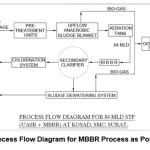 |
Figure 1: Process Flow Diagram for MBBR Process as Post Treatment Click here to view figure |
The sewage from the inlet chamber flows into pre-treatment units which include Screening chamber and Grit chamber from where screenings and grits are removed. After passing through the Parshall Flume, the sewage is distributed into UASB reactors. UASB treated effluent goes to the pre-aeration tank which is provided for 84 MLD flow with surface aerators. The effluent from pre-aeration tank is conveyed to the MBBR units for post-treatment. The treated effluent from MBBR reactors goes to secondary settling tank. Gas generated from UASB reactors and anaerobic digester is collected in membrane type biogas holder for power generation. After secondary settling tank, treated sewage is disinfected using chlorine gas before being disposed. The design parameters for the plant are presented in Table 1.
Table 1: Design Parameters for 84 MLD STP at Kosad (UASB + MBBR)
|
Sr. No. |
Parameters | Unit | Raw Sewage |
Treated Sewage |
|
1 |
pH | – | 7.2 |
7.0 -8.5 |
|
2 |
BOD | mg/l | 310 |
≤ 20 |
|
3 |
COD | mg/l | 650 |
≤ 100 |
|
4 |
Suspended Solids | mg/l | 480 |
≤ 30 |
|
5 |
Residual Chlorine | mg/l | – |
0.5 |
|
6 |
Fecal Coliform Count | MPN/100 ml | 1 x 105 |
≤ 10,000 |
performance of the STP with Inlet and Outlet Parameters (for a Period from January 2015 to December 2015) are shown in Fig. 2 to 4.
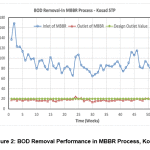 |
Figure 2: BOD Removal Performance in MBBR Process, Kosad Click here to view figure |
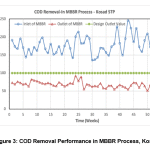 |
Figure 3: COD Removal Performance in MBBR Process, Kosad Click here to view figure |
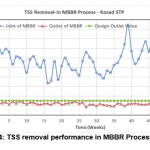 |
Figure 4: TSS removal performance in MBBR Process, Kosad Click here to view figure |
As per the data from the plant, it can be seen that MBBR plant is performing well throughout the study period of 1 year and meeting all the parameters in terms of BOD, COD & TSS even though the inlet parameters to MBBR plant are widely fluctuating. Inlet BOD values are varying from 62 to 170 mg/L where as outlet BOD values are below 20 mg/L except for one occasion (Fig.2). Inlet COD values into MBBR process are varying from 130 to 248 mg/L, outlet COD values are steadily below 100 mg/L to meet treatment requirements (Fig.3). Inlet TSS values to MBBR process are varying from 65 to 185 mg/L, outlet values are always less than 30 mg/L (Fig.4).
Study 2: Extended Aeration Process after UASB at Bamroli STP, Surat
Extended Aeration process is one of the popular process adopted in India as post treatment to UASB. It is very compact compared to polishing ponds and can give more reliable performance. Surat Municipal Corporation (SMC) has constructed 100 MLD STP at Bamroli in Surat with Extended Aeration as post treatment to UASB and is in operation since 2001. The treatment scheme of the plant is shown in Fig. 5.
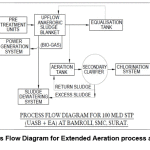 |
Figure 5: Process Flow Diagram for Extended Aeration process as post treatment |
The raw sewage after preliminary treatment enters into UASB reactors and then into aeration tanks. A secondary clarifier is provided to separate sludge from treated sewage. Chlorination is adopted as disinfection method to reduce bacterial count to permissible limits. A post equalisation tank is provided after UASB reactor for handling daily flow variations. The design input and output values for the plant are presented in Table 2. Actual performance of the plant for main parameters BOD, COD & TSS are presented graphically in Fig. 6 to 8.
Table 2: Design basis for 100 MLD STP at Bamroli (UASB + EA)
|
Sl. No. |
Parameters | Unit | Raw Sewage |
Treated Sewage |
|
1 |
pH | – | 7.2 |
7.0 – 8.5 |
|
2 |
BOD | mg/l | 300 |
≤ 20 |
|
3 |
COD | mg/l | 600 |
≤ 100 |
|
4 |
Suspended Solids | mg/l | 350 |
≤ 30 |
|
5 |
Residual Chlorine | mg/l | – |
0.5 |
| 6 | Fecal Coliform Count | MPN/100 ml | 1 x 105 |
≤ 10,000 |
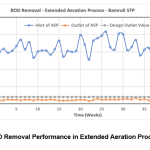 |
Figure 6: BOD Removal Performance in Extended Aeration Process,Bamroli Click here to view figure |
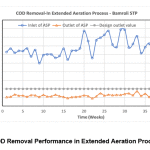 |
Figure 7: COD Removal Performance in Extended Aeration Process,Bamroli Click here to view figure |
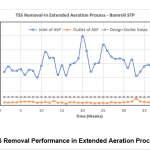 |
Figure 8: TSS Removal Performance in Extended Aeration Process,Bamroli Click here to view figure |
As seen in above graphs, the plant is performing well and meeting design requirements in terms of BOD, COD & TSS even though these parameters are fluctuating widely at the inlet of Extended Aeration process. The BOD values at the inlet of Extended Aeration process are varying from 125 to 210 mg/L whereas the outlet BOD values are consistently below 20 mg/L throughout the experiment period (Fig. 6). The COD values at the inlet of Extended Aeration process are varying from 250 to 450 mg/L, outlet values are around 50 to 60 mg/L for 90% of the time (Fig.7). Also, inlet TSS concentration of Extended Aeration process is varying between 100 to 250 mg/L, the outlet values are below 10 mg/L for most portion of the study period (Fig. 8).
Study 3: Pilot Scale SBR Plant after UASB at Kosad STP, Surat
The UASB+MBBR plant at Kosad STP, Surat was designed to achieve treated sewage parameters as mentioned in Table 2. As there was a need to enhance the capacity of the STP at Kosad, it was decided to conduct a pilot study to determine the efficacy of the SBR process as a post treatment option for the UASB treated effluent, to further improve upon the quality achieved in the existing MBBR plant. Though SBR process has nutrient removal capability, the focus of the pilot plant was mainly on the reduction of BOD, COD and TSS, as the treated sewage from Kosad was being discharged in the creek and there was no requirement to reduce the nutrients as per treated sewage quality requirements mentioned in Table 1. The pilot trials were conducted in the Laboratory at the Kosad STP.
A pilot scale plant comprising of two SBR basins was installed at Kosad STP site for the study. The SBR basins were operated in an intermittent aeration mode. Each reactor had a working volume of 140 L and another 50 L head space volume, accommodating features for filling, mixing, aerating, and decanting. The UASB effluent was fed into SBR intermittently through a pump. Aeration was provided through diffusers fixed at the bottom of the SBR basins and the air was provided by an Air Blower. The treated effluent was decanted at the end of the cycle through Solenoid valves situated at various levels. The Dissolved Oxygen (DO) and Mixed Liquor Suspended Solids (MLSS) were measured through respective analysers. A level switch was provided at the maximum water level of the SBR basin to stop the inlet pump in case of high level. The operation of the pumps, blower and the solenoid valves were controlled by a PLC unit, which was programmed to automatically operate the pilot based on predetermined time sequence.
The treated sewage from the existing UASB was used for the pilot trials. The pilot plant was established and operated for a period of Four months from May 2015 to August 2015. The MLSS was maintained at 3500 mg/l and the F/M ratio was maintained between 1.0 and 1.5. The SBR was operated using a 4 hour cycle with 2 hours for Filling and Aeration, 1 hour for settling and 1 hour for decanting. The Dissolved Oxygen level was maintained between 1.5 to 3.0 during the trial period.
The performance of the SBR pilot plant was evaluated by analyzing the quality of the inlet and outlet in a periodical manner. The physico-chemical analysis included pH, temperature, Total Suspended Solids (TSS), Chemical Oxygen Demand (COD) and Biochemical Oxygen Demand (BOD). All analysis was performed according to standard methods for analysis of water and wastewater, APHA et al11.
The SBR was seeded with Activated Sludge from an existing ASP plant and the plant was started in May 2015 during which time consistent and stable operation was established by adjusting the process variables like MLSS, F/M ratio, HRT etc. The actual pilot data that was accumulated from June to August 2015 is presented in Fig. 9 to 11.The inlet BOD, COD and TSS values of pilot plant varies between 82 to 252 mg/L, 176 to 528 mg/L and 118 to 298 mg/L respectively whereas the outlet BOD, COD and TSS varied between 6 to 11 mg/L and 31 to 56mg/L and 6 to 12mg/L respectively. The average BOD, COD and TSS values were found to be much better as compared to the treated sewage characteristics of the existing MBBR plant.
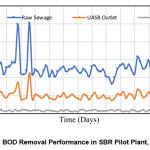 |
Figure 9: BOD Removal Performance in SBR Pilot Plant, Kosad Click here to view figure |
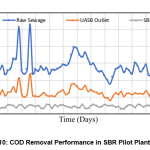 |
Figure 10: COD Removal Performance in SBR Pilot Plant,Kosad Click here to view figure |
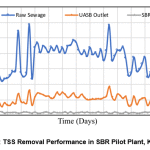 |
Figure 11: TSS Removal Performance in SBR Pilot Plant,Kosad Click here to view figure |
The UASB-SBR process achieved a treated water quality of BOD < 10 mg/L, COD <50 mg/L and TSS < 10 mg/L. The SBR outlet BOD, COD and TSS did not vary despite variation in the inlet quality. The pilot plant employed a simple valve based decanting system for removing the treated water. In actual plant conditions, with advanced decanting mechanisms, it is possible to achieve still lower TSS at the outlet. It was found that an HRT of 12 hours was optimal in achieving the desired quality. The integrated UASB – SBR system is a very good alternative for the treatment of waste waters, as it meets the desired standards at a lower overall capital and operating cost.
Results of Different Studies
Table 3 shows average values of inlet and outlet concentrations of BOD, COD and TSS for Extended Aeration, MBBR and SBR processes.
Table 3: Performance of Post UASB treatment processes in Sewage Treatment
|
Sl. No. |
Plant | Post UASB process | UASB Outlet (mg/L) | Final outlet (mg/L) | ||||
| BOD | COD | TSS | BOD | COD |
TSS |
|||
|
1 |
Kosad | MBBR | 91 | 177 | 115 | 18 | 68 |
24 |
|
2 |
Bamroli | Extended Aeration | 162 | 337 | 149 | 12 | 60 |
12 |
|
3 |
Kosad | SBR – Pilot plant | 53 | 127 | 55 | 8.3 | 44.2 |
9.0 |
Conclusion
Worldwide experience shows that UASB can be effectively used for domestic sewage treatment. However, it requires an efficient post treatment to meet the discharge standards. The Two full scale plants under operation with Post treatment as Extended Aeration & MBBR and One Pilot Plant on SBR Process were studied. Performance of all the three process are satisfying the design requirements. Due to more stringent discharge norms in recent times including nutrient removal, process like SBR is adopted. The pilot scale plant performance details of SBR proved that it can meet stringent discharge standards and the treated sewage can also be reused for industrial use with or without further treatment based on treated water quality requirement.
Acknowledgement
The Authors are thankful to UKA Tarsadia University, Bardoli, India for encouraging for the Study. The Authors are also thankful to M/s. SFC Environmental Technologies Pvt. Ltd., Mumbai for technical support for establishing Pilot plant of SBR.
Conflict of Interest
Authors declare that they have no conflict of interest.
References
- Sato, N., Okubo.T., Onodera, T., Ohashi, A. and Harada, H., “Prospects for a Self-Sustainable sewage treatment system : A case study on full-scale UASB system in India’s Yamuna River Basin,” Journal of Env. Management, 2006, 80(3), 198-207.
- Chernicharo, C.A.L., “Post-treatment options for the anaerobic treatment of domestic wastewater,” Review in Eng. Sci. and Bio/Tech., 2006, 5, 73-92.
- Khan, A., Khan, P., Wiegant, W., Schaapman, J.E. and Sikka, B., “Implementation of UASB technology in river conservation projects in India – policy development for wastewater treatment,” Proceedings of 9th international conference on Anaerobic Digestion, Belgium, 2001, 151-156.
- Von Sperling, M. and Chernicharo, C.A.L., Biological Wastewater Treatment in Warm Climate Regions, IWA Publishing, London, 2005
- Chernicharo, C.A.L. and Nascimento, M.C.P., “Feasibility of a pilot-scale UASB/trickling filter system for domestic sewage treatment,” Sci.Tech. 2001, 44(4), 221-228.
- Arceivala, S.J., Wastewater Treatment for Pollution Control. Tata McGraw-Hill Pub. Comp. Ltd., New Delhi, India., 1999
- Tawfik, A., Zaman, G., Klapwijk, A., Sanders, W., El-Gohary, F. and Lettinga, G., “Treatment of domestic sewage in a combined UASB/RBC system. Process optimization for irrigation purpose,” Sci. Tech., 2003, 48 (1), 131-138.
- Haruhiko Sumino, Masanobu Takahashi, Takashi Yamguchi, Kenichi Abe, Nobuo Araki, Shinichi Yamazaki, Satoshi Shimozaki, Akihiro Nagano, Naumichi Nishio, “Feasibility study of a pilot-scale sewage treatment system combining an up-flow anaerobic sludge blanket (UASB) and an aerated fixed bed (AFB) reactor at ambient temperature”, Bioresource Technology, 2007, 98( 1),177-182
- Khan AA, Gaur RZ, Tyagi VK, Khursheed A, Lew B, Mehrotra I, Kazmi AA, “Sustainable options for post treatment of UASB effluent treating sewage: a review”, Resour Conserv Recycling, 2011, 55: 1232–1251.
- Abid Ali Khan, Rubia Zahid Gaur, Indu Mehrotra, Vasileios Diamantis, Beni Lew and Absar Ahmad Kazmi, Performance assessment of different STPs based on UASB followed by aerobic post treatment systems, Journal of Environmental Health Science and Engineering, 2014, 12:43
- “Standard Methods for examination of Water and Wastewater, American Public Health Association (APHA), Washington D.C., USA,” (1998)

This work is licensed under a Creative Commons Attribution 4.0 International License.









